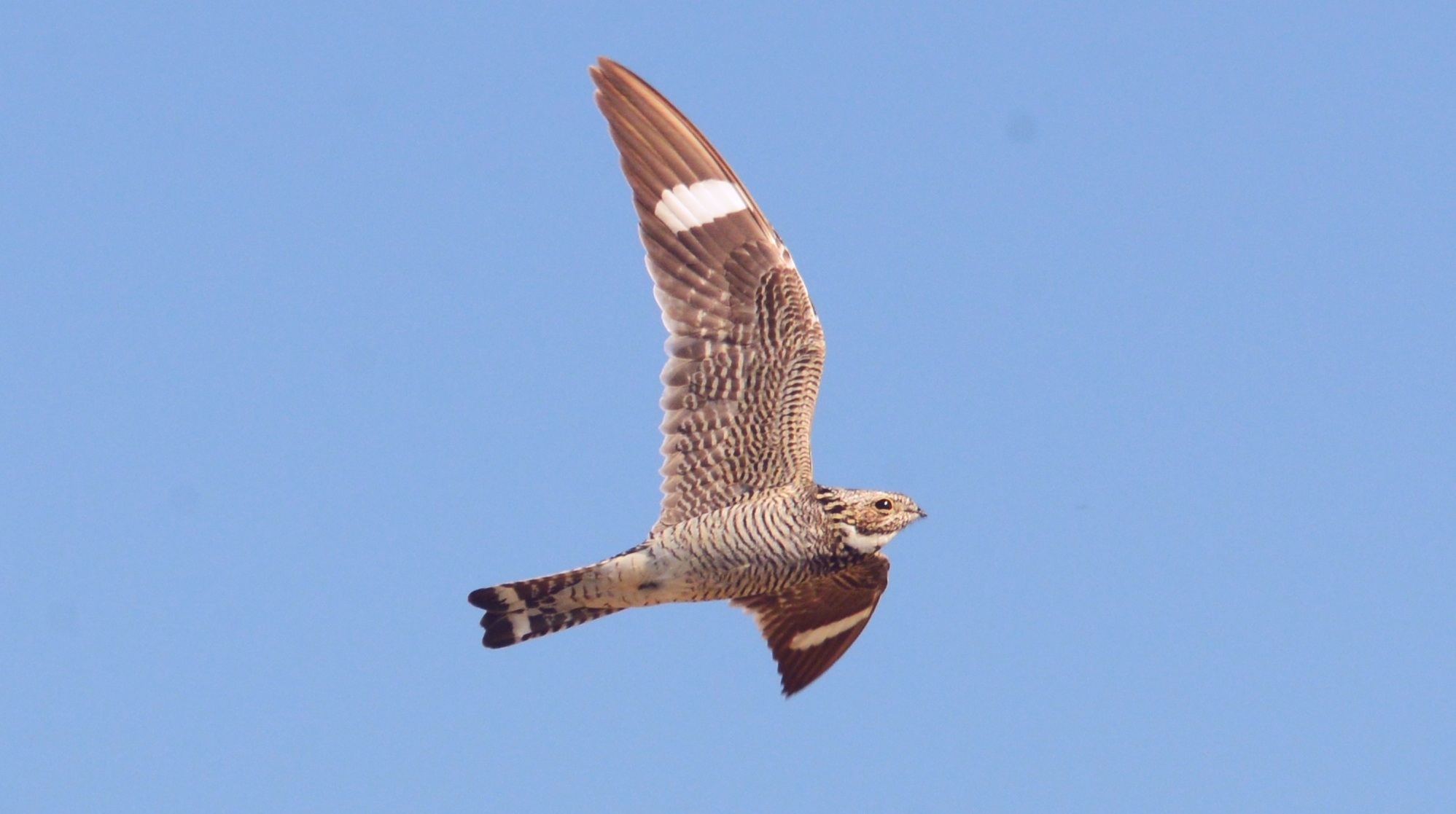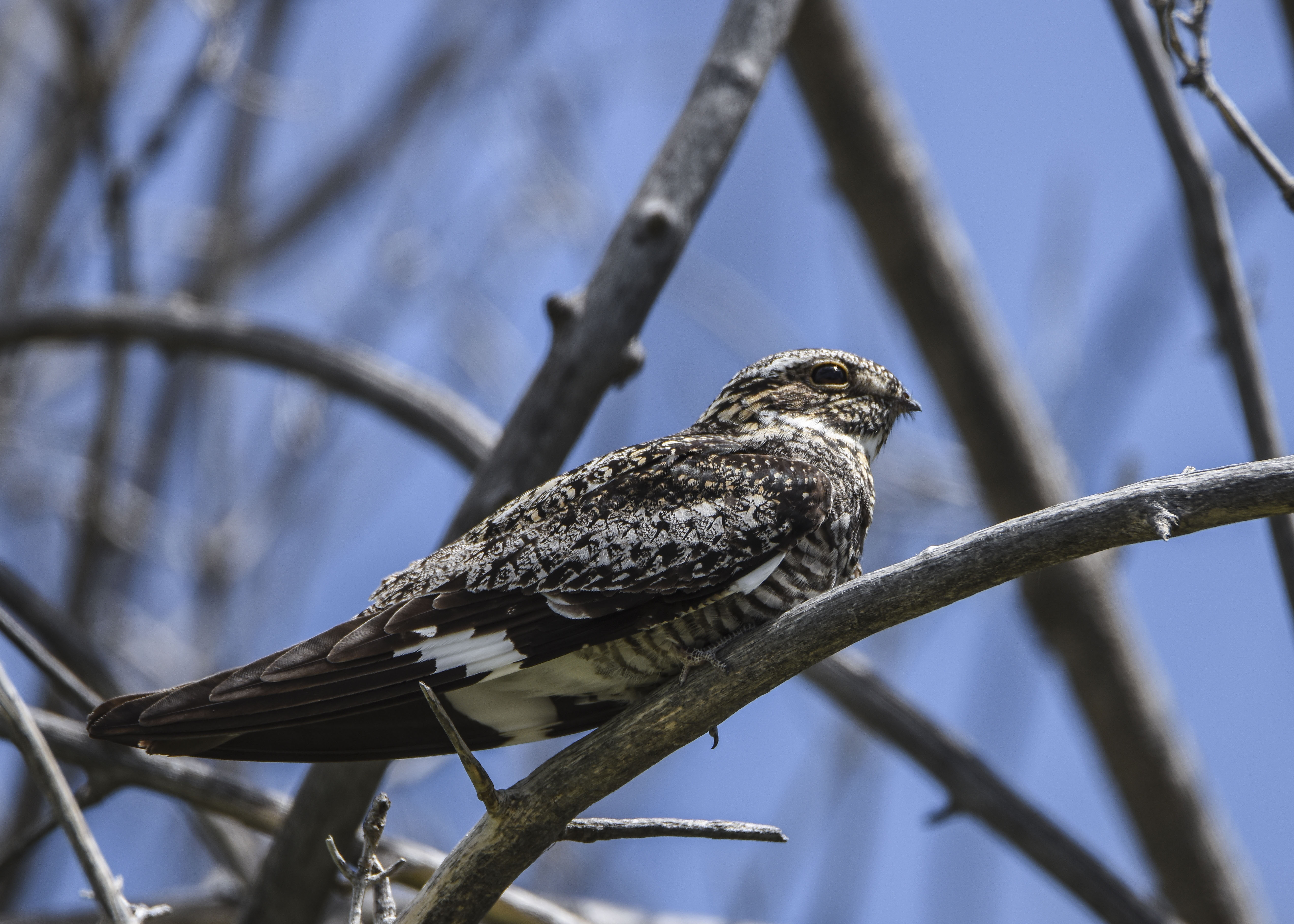Common Nighthawk

General description:
Other than the prominent wing patch that can sometimes be visible at rest and a white Vee under the chin, also visible during flight, the common nighthawk is well camouflaged in a mottled pattern of gray, brown, white and black. Since these birds nest on the ground, their coloration helps them to hide in plain sight. This medium-sized bird, in between a robin and crow in size, also has long pointed wings.
Common nighthawks are members of the nightjar family of birds which includes nightjars, nighthawks, poorwills and whip-poor-wills. Despite their name, they have little ancestral connection to true hawks. All have large eyes, flat short bills and short necks, giving them a chunky big-headed appearance.
Behavior and Habitat
There are a lot of ground-nesting birds and common nighthawks are not unusual in that respect. What makes them different from most is that the female makes no attempt to form a nest of any kind. She just plops out two eggs right on the ground. In fact, in many cities, common nighthawks chose flat rooftops when suitable ground nesting isn’t possible.
Common Nighthawks eat flying insects almost exclusively. The Common Nighthawk hunts on the wing at dawn and dusk, opening its tiny beak to reveal a cavernous mouth well suited for snapping up flying insects. It often takes advantage of clouds of insects attracted to streetlamps, stadium lights, and other bright lights but seems to never hunt in full darkness.
Similar Species
There are other species in this family than can be confusing such as the Eastern Whip-poor-Will and the Lesser Nighthawk. However, neither are found at Camas. The most likely bird to confuse with the Common Nighthawk is the American Kestrel. Watch for the white wing patches on the nighthawk to end any confusion.
Cool Facts
The normal call of the common nighthawk is a sharp high-pitched “peent” sound. If you don’t like fingernails scratching a chalkboard, you won’t like this sound either. More interesting though, is the sound the male makes when courting and driving off intruders. He flies straight at the ground, pulling up just a few feet short. The air across hisses across his tail feathers creating a loud noise called a boom.

When and where found at Camas NWR
You can see nighthawks flying anywhere on the refuge where flying insects abound (just about everywhere). They can be found roosting in the cottonwoods west and north of headquarters.
Conservation
“In the U.S., Common Nighthawk populations declined by almost 2% per year between 1966 and 2014, amounting to a cumulative decline of 61%, according to the North American Breeding Bird Survey. Canadian populations experienced declines of over 4% and recent data suggest the species’ numbers may have dropped more than half in Canada since the mid-1960s. Hard numbers are difficult to come by because the Common Nighthawk's cryptic colors and nearly nocturnal habits make them difficult to count during standardized surveys. Partners in Flight estimates the global breeding population at 16 million, with 88% breeding in the U.S., 5% in Canada, and 4% spending some part of the year in Mexico. The 2014 State of the Birds Report lists Common Nighthawk as a Common Bird in Steep Decline, and the species rates an 11 out of 20 on the Partners in Flight Continental Concern Score. Across North America, threats include reduction in mosquitoes and other aerial insects due to pesticides, and habitat loss including open woods in rural areas and flat gravel rooftops in urban ones. Nighthawks are also vulnerable to being hit by cars as they forage over roads or roost on roadways at night. People have had some success creating nesting habitat by placing gravel pads in the corners of rubberized roofs and by burning and clearing patches of forest to create open nesting sites.”
https://www.allaboutbirds.org/guide/Common_Nighthawk/lifehistory#conservation
Text by Terry Thomas. Source: https://www.allaboutbirds.org
Photos by Terry Thomas and Michael Quist.